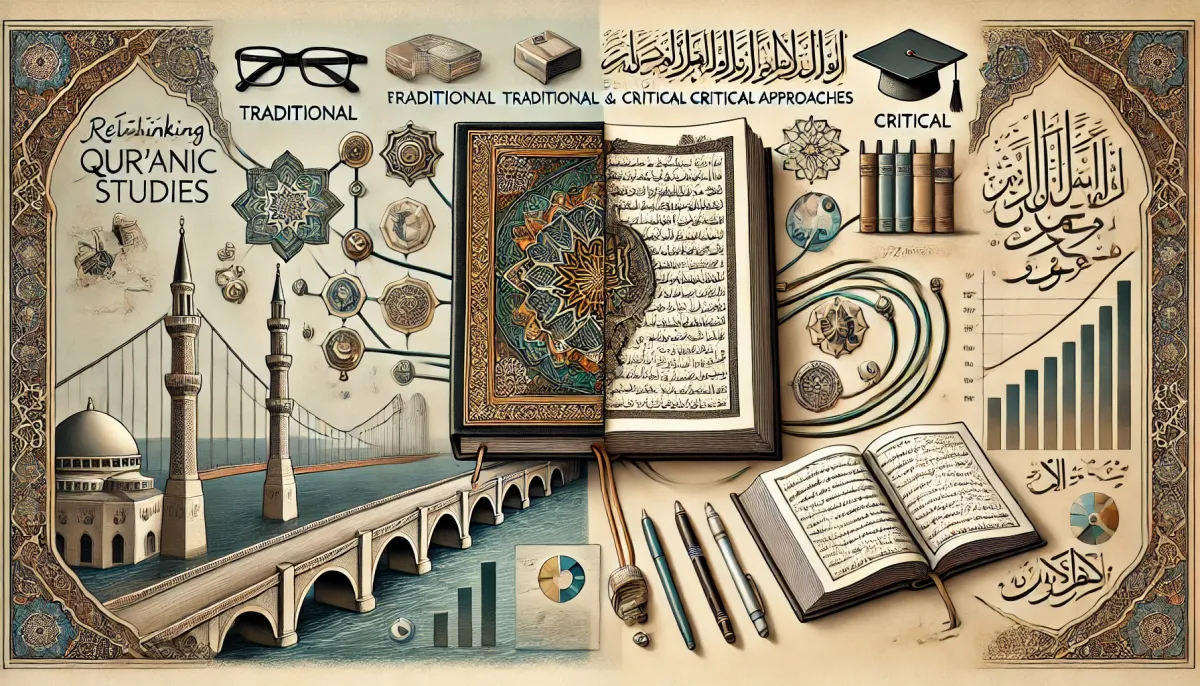

By Dr. Tim Orr
This article combines a critical evaluation of existing methodologies with a proposal for advancing Qur'anic studies through Andy Bannister's integrative approach, aiming to bridge the gaps identified in traditional and critical perspectives.
Introduction
The Qur'an, revered as the divine word by millions, presents a rich tapestry for scholarly interpretation. Over the centuries, it has been studied through traditional religious exegesis and modern critical methods, each offering unique insights but also facing limitations. This article explores these approaches' constraints—specifically the traditional, hard, and soft critical methods—and introduces Andy Bannister's integrative thesis as a promising avenue for future scholarly pursuit.
The Limitations of Traditional and Critical Approaches
Traditional Approach Limitations
The traditional approach, deeply rooted in Islamic orthodoxy, primarily uses religious narratives and Hadith to interpret the Qur'an. While this method emphasizes the spiritual and theological aspects, it often lacks rigorous historical and textual analysis, which are crucial for understanding the Qur'an's context, authorship, and evolution. This perspective risks oversimplifying the complex historical processes behind the text’s formation.
- Reference: Berg, H. (Ed.). (2010). Methods and Theories in the Study of Islamic Origins. Brill. This collection discusses the limitations of relying solely on traditional Islamic sources for understanding the Qur'an’s historical context.
Hard and Soft Critical Approach Limitations
Hard Critical Approach:
- Over-reliance on External Critiques: This approach often depends on non-Islamic historical sources and academic theories that might not fully align with the internal religious context of the Qur'an, potentially leading to skewed interpretations.
- Radical Skepticism: It challenges the divine origin and traditional history of the Qur'an, risking alienation of traditional scholars and believers and possibly overlooking the text's deeper spiritual implications.
- Reference: Saleem, S. (2018). Revisiting the Qur'anic Text: Historical and Literary Investigations. Palgrave Macmillan. This book discusses the impact of radical skepticism in Qur'anic studies and its potential to alienate traditional interpretations.
Soft Critical Approach:
- Insufficient Integration: While it aims to bridge traditional and modern criticisms, it sometimes struggles to provide a convincing synthesis, often failing to fully reconcile historical criticism with theological insights.
- Limited by Contemporary Understandings: This approach can be constrained by the limitations of current academic methodologies, possibly not capturing the full nuance of the Qur'an's early Islamic environment.
- Reference: Reynolds, G. S. (Ed.). (2008). The Qur'an in Its Historical Context 2. Routledge. This volume explores the challenges of integrating historical contexts with theological perspectives in Qur'anic studies.
The Way Forward: Andy Bannister's Thesis
Given the discussed limitations, exploring Andy Bannister's thesis could provide a novel perspective. Bannister integrates theological, philosophical, and historical analyses, potentially offering a more balanced understanding of the Qur'an.
Exploring Bannister's Thesis
- Theological and Historical Synthesis: Bannister's work proposes a synthesis of theological themes with historical and philosophical inquiries, aiming to bridge the divide between divine revelation and historical text development.
- Addressing Critical and Traditional Gaps: His thesis focuses on unresolved questions by both traditional and critical methods, striving for a more comprehensive understanding of the Qur'an.
- Reference: Bannister, A. (2015). The Qur'an: A Philosophical Guide. Edinburgh University Press. This book provides insights into how Bannister’s approach bridges gaps in traditional and critical Qur'anic studies.
Conclusion
The exploration of traditional and critical methodologies in Qur'anic studies highlights the need for a more integrative approach. Andy Bannister's thesis suggests a pathway forward that respects the Qur'an's religious significance while applying rigorous scholarly critiques. This integrative approach promises to enrich the academic discourse around the Qur'an, providing deeper insights into its composition and significance.
- Reference for Conclusion: Ali, K. (2014). The Qur'an: An Encyclopedia. Routledge. This encyclopedia entry summarizes the need for new methodologies in Qur'anic studies that integrate traditional beliefs and modern academic critiques.
References
- Ali, K. (2014). The Qur'an: An Encyclopedia. Routledge.
- Bannister, A. (2015). The Qur'an: A Philosophical Guide. Edinburgh University Press.
- Berg, H. (Ed.). (2010). Methods and Theories in the Study of Islamic Origins. Brill.
- Reynolds, G. S. (Ed.). (2008). The Qur'an in Its Historical Context 2. Routledge.
- Saleem, S. (2018). Revisiting the Qur'anic Text: Historical and Literary Investigations. Palgrave Macmillan.
